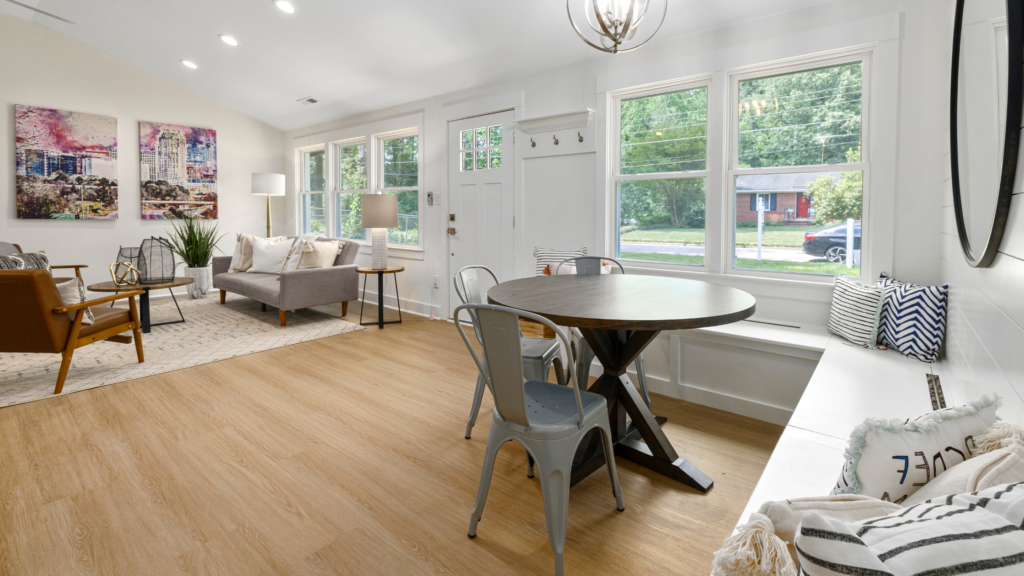The Benefits of Organic and Non-Toxic Furniture for a Healthier Home

Home is more than just a place to sleep—it’s where we spend time with loved ones, relax after a long day, and create lasting memories. But what if your furniture is silently impacting your health? Many conventional furniture pieces contain toxic chemicals that can affect indoor air quality, leading to health concerns over time.
That’s why more homeowners are making the switch to organic and non-toxic furniture. Choosing pieces made from natural, chemical-free materials can transform your living space into a safer, healthier environment while also supporting sustainability.
How Conventional Furniture Can Affect Your Health
You may not realize it, but the furniture in your home could be releasing volatile organic compounds (VOCs) and other harmful chemicals into the air. Many mass-produced sofas, mattresses, and wooden furniture pieces contain synthetic materials, glues, and flame retardants that slowly break down, releasing toxins into your home environment.
Common Chemicals Found in Furniture
Many people assume that if a piece of furniture looks good and feels comfortable, it must be safe. Unfortunately, that’s not always the case. Here are some of the most common chemicals lurking in traditional furniture:
- Formaldehyde – Found in pressed wood, adhesives, and some upholstery fabrics, this chemical can cause respiratory irritation and allergic reactions.
- Flame Retardants – Often used in sofas and mattresses, these chemicals have been linked to hormone disruption and developmental issues.
- Polyurethane Foam – This synthetic material, used in cushions and mattresses, can release VOCs into the air over time.
- Pesticides and Fungicides – Frequently found in non-organic cotton and wood treatments, these chemicals can cause skin irritation and long-term health concerns.
Breathing in these toxins daily can lead to headaches, allergies, and even long-term respiratory problems. For families with young children or pets, the risks are even greater since they spend more time in close contact with furniture surfaces.
The Key Benefits of Organic and Non-Toxic Furniture

Switching to organic and non-toxic furniture isn’t just about avoiding harmful chemicals—it’s about creating a home that supports better health, sustainability, and long-term comfort. Here are the biggest advantages of making the switch:
1. Healthier Indoor Air Quality
One of the most immediate benefits of choosing organic furniture is the dramatic improvement in air quality. Unlike conventional pieces that release VOCs, non-toxic furniture made from natural materials doesn’t emit harmful gases.
How It Helps:
- Reduces respiratory issues and allergies
- Lowers the risk of headaches and skin irritation
- Helps maintain cleaner indoor air, especially in bedrooms
2. Safer for Children and Pets
Young children are especially vulnerable to toxins because they frequently touch and chew on furniture surfaces. Likewise, pets spend a lot of time lying on floors and sofas, increasing their exposure. By choosing organic, chemical-free materials, you create a much safer environment for your loved ones.
Safer Choices Include:
- Natural wool padding (flame-resistant without chemicals)
- Organic cotton upholstery (free from pesticides and synthetic dyes)
- Solid hardwood frames (instead of particleboard with formaldehyde glue)
👉 Upgrade your home: Explore organic and chemical-free furniture options here.
3. Sustainability and Eco-Friendliness
Beyond personal health, switching to non-toxic furniture is an environmentally responsible choice. Conventional furniture production often involves deforestation, synthetic chemicals, and wasteful practices. Sustainable furniture brands focus on:
- Using responsibly sourced wood (like FSC-certified lumber)
- Avoiding toxic finishes that pollute the environment
- Supporting fair trade practices in organic material sourcing
Buying high-quality, durable furniture also means fewer replacements, reducing landfill waste.
4. Better Durability and Long-Term Investment
High-quality organic furniture isn’t just good for the environment—it lasts significantly longer than mass-produced alternatives. Cheap furniture made from particleboard and synthetic foams tends to break down quickly, while natural materials like solid wood, natural latex, and organic cotton hold up for decades.
Why It’s a Smart Investment:
- Solid hardwood frames are stronger than particleboard
- Natural latex cushions maintain shape longer than polyurethane foam
- Chemical-free upholstery resists wear and fading better
How to Identify and Choose Non-Toxic Furniture
With so many products claiming to be “eco-friendly,” how can you ensure you’re making a truly healthy choice? Here’s what to look for:
1. Certified Organic and Non-Toxic Materials
| Certification | What It Ensures |
|---|---|
| GOTS (Global Organic Textile Standard) | Organic fabrics free from harmful chemicals |
| OEKO-TEX® Standard 100 | Materials tested for toxic substances |
| GREENGUARD Gold | Low chemical emissions for better indoor air quality |
| FSC (Forest Stewardship Council) | Sustainable and responsibly sourced wood |
If a product doesn’t have a certification, check the manufacturer’s transparency about materials used.
2. Safe and Sustainable Fillings
What’s inside your furniture matters just as much as the exterior. Avoid polyurethane foam and look for natural alternatives like:
- 100% natural latex (free from synthetic chemicals)
- Organic wool (naturally flame-resistant)
- Organic cotton (soft and breathable, without pesticides)
3. Solid Hardwood vs. Pressed Wood
When buying furniture with wooden components, choose:
✅ Solid hardwood (like maple or oak)
🚫 Avoid MDF and particleboard, as they contain formaldehyde-based adhesives.
👉 Make the switch today: Find handcrafted, solid wood furniture here.
Practical Steps to Transition to an Organic Home
Switching to non-toxic furniture doesn’t mean replacing everything overnight. Here’s how to make a smooth transition:
1. Prioritize High-Impact Areas
Start with the rooms where you spend the most time, like:
- Bedrooms (organic mattresses, non-toxic bed frames)
- Living rooms (chemical-free sofas and coffee tables)
- Children’s play areas (safe, VOC-free seating)
2. Improve Indoor Air Quality
Even if you’re not replacing all your furniture at once, you can reduce toxins by:
- Using air purifiers to filter VOCs
- Choosing zero-VOC paints for furniture refinishing
- Placing houseplants like snake plants or peace lilies, which absorb indoor toxins
3. Research Before Buying
Check brand transparency before purchasing. Many companies greenwash their products, claiming to be eco-friendly while still using harmful chemicals. Always verify materials and certifications before making a decision.
Final Thoughts: Why Your Home Deserves Non-Toxic Furniture
Creating a healthier home starts with the choices you make about your furniture. By choosing organic, chemical-free materials, you protect your family from harmful toxins, support sustainability, and invest in quality that lasts.
Whether you’re upgrading your mattress, sofa, or wooden furniture, The Futon Shop offers a range of organic, handcrafted options designed for a toxin-free home.
👉 Ready to make the switch? Explore non-toxic, organic furniture here.



